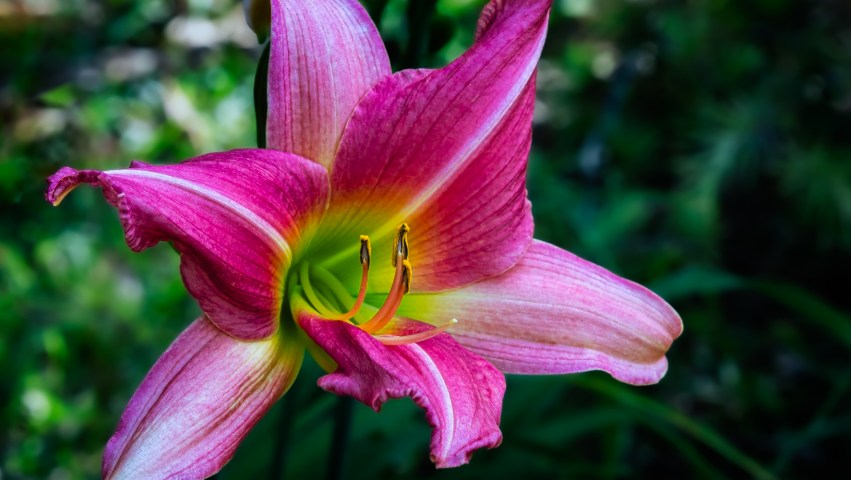From “Gardening” in So Late, So Soon by Linda K. Anderson:
“Ahhh, gardening. I adore digging in the dirt, especially in my North Carolina garden. I’m a good gardener, probably more from diligence and determination than a green thumb. Nature is so giving….
“With my hands in the dirt and the sun warming my back, I soak in the silence, or hum with the buzzing of a bee, and breathe the subtle scent of honeysuckle twining on the fence. Plucking, pulling, and weeding works muscles needing the activity. I make a cavity for a seed to take root while a Purple Finch lands softly five feet from me to scratch the earth, a bee sucks nectar from a red daylily, and a silky breeze kisses my cheek and stirs my hair….
“How rich I am with all this beauty. I feel at home with nature, in a peaceful small world of my own. Feeling at home and welcome.”
From “Purple Daylily” in Hidden Among the Petals by Beverly Hughes:
“In 1997, a fascinating event took place for me when I was in a greenhouse in Springfield, Delaware County in Pennsylvania. I thought that the only daylilies that existed were the wild orange ones that grew along the roadside during the summer. From my personal observation of growing certain purple and pink daylilies, they begin to start opening about 1:00 a.m. in the morning and maintain its beautiful color and texture until about 11:00 a.m. Then the flower tissue and color begins to breakdown, and by sundown, the bloom closes forever.”
From “Hemerocallis thunbergii Baker” in Hemerocallis, The Daylily by R. W. Munson, Jr.:
“A daylily was mentioned under the name Hemerocallis thunbergii by Peter Barr in 1873, as a plant that starts to flower somewhat later then H. fulva (the Europa Daylily), has flowers a clear, beautiful, yellow color, and is 3 ft. tall. This plant was first listed for sale in the catalog of Barr and Sugden in 1873….
“Plants of Thunberg’s Daylily, of the clone widely cultivated and believed to be that named by [John Gilbert] Baker, have a robust and compact habit of growth and are strongly spreading in the crown by short, erect branches. The roots are somewhat enlarged and fleshy. The foliage is medium dark green and ascending-spreading to a general level of about 30 in., and dies in late autumn, usually not until after frost. The scapes are numerous, slender, stiffly erect to a height of about 45 in., and are well-branched above. The flowers are lemon-yellow in color with the tube and the outside of the sepals strongly tinged green…. Flowering is in midsummer; in New York it blooms in July along with the Europa Daylily and after plants of H. flava and H. minor have ceased to bloom….
“Thunberg’s Daylily has an excellent robust habit, attractive dark green foliage, and an abundance of flowers…. Thunberg’s Daylily is rather widely known in American gardens.”
Hello!
Here we wrap up daylily photography for 2024 (unless I find some late-bloomers) with three collections, of red, purple, and yellow daylilies.
I found the plants with large yellow flowers in more woodsy areas of Oakland Cemetery’s gardens — growing in the sunny outer edges of some plots of land filled with large trees or shrubs. That they bloomed so well in partly sunny areas suggested that I might be able to grow them in my own mostly-shade garden, so perhaps next spring I’ll look for some yellow companions for my Witch’s Hand Daylilies.
I came across the red and purple daylilies on my way out of the gardens one day, after having already spent a couple of hours in the hot sun on a photography excursion. Both batches were clearly in the late stages of their blooming season, but I held off my desire to get back into air-conditioning and got them to pose for photos. The purple ones probably had only a few more days of blooming left, but I thought it was interesting that — you can see this in the first three photos — the purple color fades to blue as the flower petals wither. While I might have normally skipped photographing flowers with half-dead petals, I liked the contrast between the purple and blue so kept a few of them in my collection.
Thanks for taking a look!















































































































































































